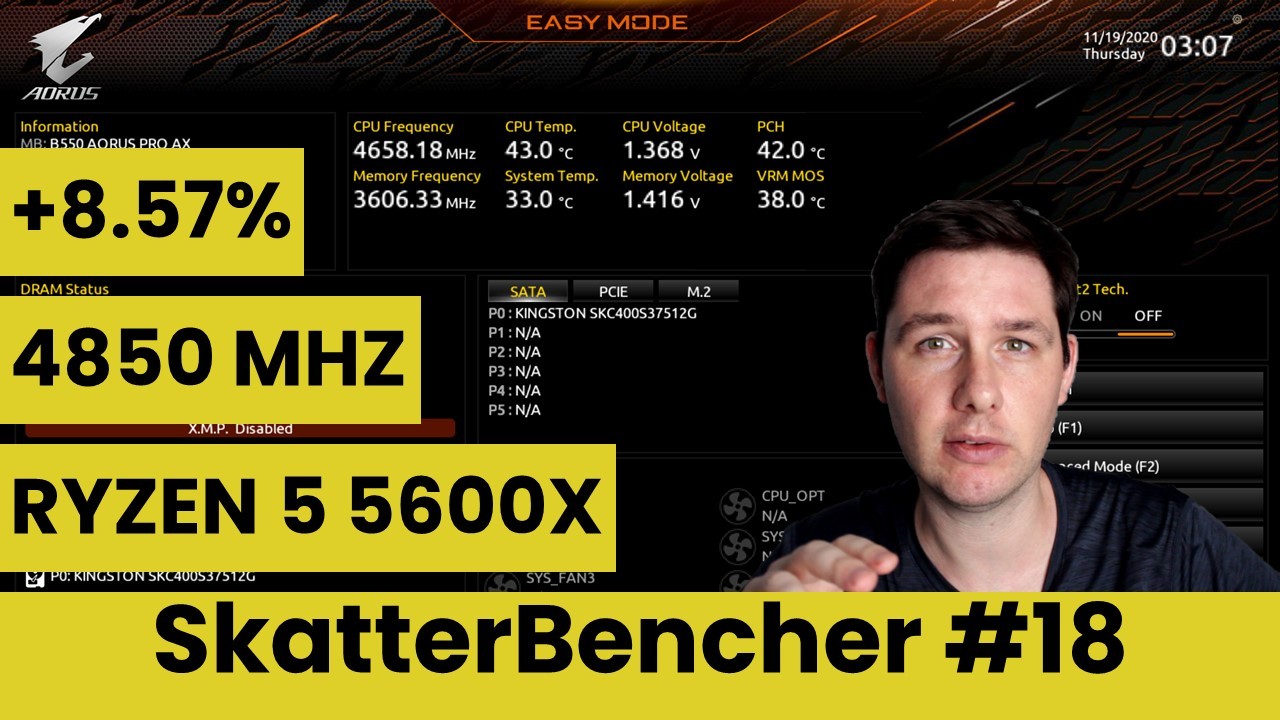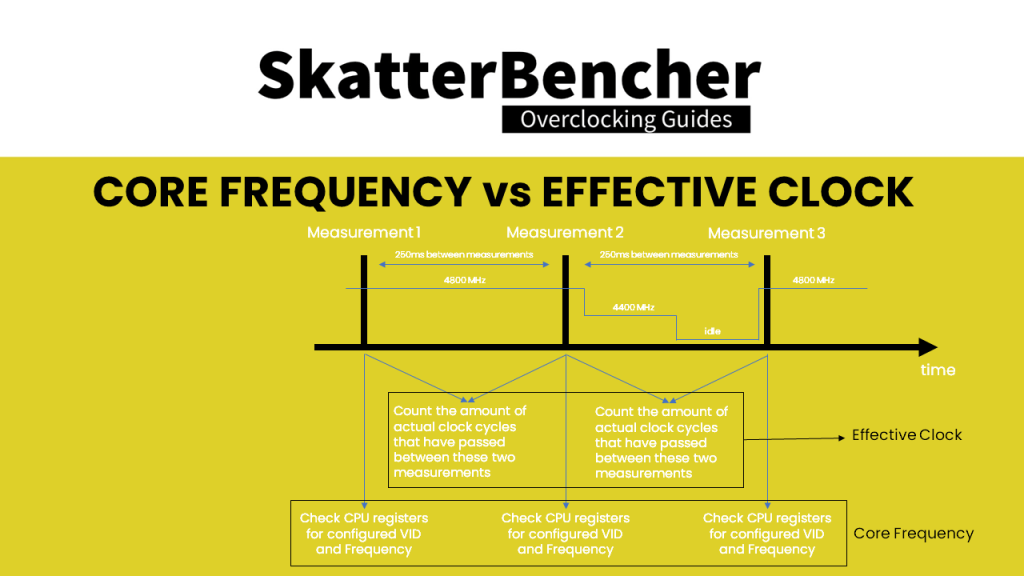SkatterBencher #18: AMD Ryzen 5 5600X Overclocked to 4850 MHz

We overclock the AMD Ryzen 5 5600X processor up to 4.85 GHz with the GIGABYTE B550 AORUS PRO AX motherboard and EK water cooling.
Introduction
To be honest I though I was done with the Ryzen 5000 series after the 3 previous videos, but then I realized I forgot the Ryzen 5. So in today’s video we’ll be overclocking the AMD Ryzen 5 5600X Zen 3 Vermeer processor to 4.65 GHz all-core with a CPU voltage of 1.375V.
The Ryzen 5 5600X is the lowest of the four products that were included in AMD’s launch of the Ryzen 5000 processor family. Ryzen 5000 is powered by the Zen 3 micro architecture codenamed Vermeer.
Vermeer is similar to the previous Zen generations and is also powered by a 7nm process node. The main benefits can be found in the significantly increased performance per clock and increased frequencies at a similar power level. The CPU is still chiplet based and features the same IO die as the previous generations.
The Ryzen 5 5600X offers 6 cores and 12 threads with a listed base frequency of 3.7 GHz and a listed boost frequency up to 4.6 GHz. It is rated at 65W TDP and should retail at an MSRP of $299. The CPU should have been available from November 5th in stores around the world.
In this video we will cover the basic overclocking steps to get your CPU all the way to 4.65 GHz using custom loop water cooling.
We will dig into four overclocking scenarios.
First, we will run the CPU with PBO and XMP enabled
Second, we’ll overclock the CPU to its maximum stable Prime 95 settings.
Third, we’ll push the CPU further to its all-core stable maximum frequency.
Fourth, we’ll focus in on Precision Boost Overdrive and try to “big brain” our way to a little more performance.
Before we get going, we need to talk a little bit about the overclocking constraints and our platform.
AMD Ryzen 5 5600X: Platform Overview
Along with the AMD Ryzen 5 5600X processor, in this guide we will be using the GIGABYTE B550 AORUS PRO AX motherboard, an NVIDIA RTX 2080 Ti, a pair of G.SKILL Trident Z DDR4-4266 memory sticks, a Seasonic Prime 850W Platinum power supply, the Elmorlabs P80DB2 LPC Debug Card, and of course EK-Quantum water cooling.
All this is mounted on top of our favorite Open Benchtable.
The cost of the components should be around $3,010
- CPU: $299 https://amzn.to/39U3o9t
- Cooling: $200 + $400 https://amzn.to/3c5szsJ
- Motherboard: $200 https://amzn.to/2Ngmnn4
- VGA: $1300 https://amzn.to/39RkQLZ
- Memory: $180 https://amzn.to/3qF8iya
- Power Supply: $200 https://amzn.to/3nYzFl9
- Debug card: $30 https://www.elmorlabs.com/
- Benchtable: $200 https://openbenchtable.com/
AMD Ryzen 5 5600X: Overclocking Constraints
Before we get started with the overclocking, let’s cover some of the constraints we will face.
A Ryzen 5000 CPU consists of a couple of parts. Each CPU has multiple chiplets. A chiplet is a die with specific functions such as CPU cores, IO hub, Memory controller, and so on. All the chiplets communicate each other via the fabric interconnect.
A Core Chiplet Die, or CCD, is one of the chips on the AMD CPU. While a CCD used to consist of two CCXs paired together, on Zen 3 a CCD consists of a single CCX.
CCX is short for Core Complex. The Core Complex consists of 8 individual cores each with their L1 and L2 cache. They also share a large 32MB L3 cache.
The Ryzen 5 5600X has 1 CCDs with 1 CCX. The CCX has six out of the eight cores enabled.
AMD’s default frequency offers aggressive clock frequency of individual cores based on the temperature and power consumption headroom, as well as the core quality.
While AMD offers aggressive frequency boost for single threaded applications, it does not offer to set the single threaded boost frequency when manually overclocking. This means that if you overclock manually you will lose the single thread frequency advantage.
Also, AMD also does not offer an AVX offset that can reduce the operating frequency when for example running Prime 95.
Lastly, by default the fabric, memory controller and memory frequency operate in “synchronous mode”. That means typically the CPU will run all frequencies in 1 to 1 ratio. On Ryzen 5000, synchronous mode is supposed to work up to 2000 MHz, after which the system switches to asynchronous mode. In asynchronous mode, the memory controller will operate at half the frequency of the system memory. The fabric clock will also run below system memory frequency. So, you will have a performance penalty. The penalty can be overcome by increasing the memory frequency to well over DDR4-4000 speeds.
With all this in mind, let’s jump into the benchmarks and overclocking.
Benchmarking Software
Here’s a list of the benchmarks and software utilities used in this guide, including download links:
- SuperPI 4M https://www.techpowerup.com/download/super-pi/
- Geekbench 5 https://www.geekbench.com/
- HWBOT X265 https://hwbot.org/benchmark/hwbot_x265_benchmark_-_4k/
- Cinebench R23 https://www.maxon.net/en/cinebench
- V-Ray 5 https://www.chaosgroup.com/vray/benchmark
- Final Fantasy XIV https://na.finalfantasyxiv.com/benchmark/
- Prime 95 Small FFT with AVX https://www.mersenne.org/download/
AMD Ryzen 5 5600X: Stock Performance
Before we get started with pushing the performance of the AMD Ryzen 5 5600X processor, let’s first take a look at the scoring at stock settings:
- SuperPI 4M: 36.167 seconds
- Geekbench 5 (single): 1,540 points
- Geekbench 5 (multi): 7,769 points
- HWBOT X264 4K: 14.216 fps
- Cinebench R23: 11,002 points
- V-Ray 5: 8,290 vsamples
- Final Fantasy XIV: 178.30 fps
Step 1: Precision Boost Overdrive and XMP
As a first step, we wanted to enable Precision Boost Overdrive and XMP. But, turns out on this motherboard Precision Boost Overdrive is enabled by default. So that makes it really easy.
As a reminder: Precision Boost Overdrive aims to maximize performance in case your system is equipped with extra cooling capacity and adequate system components.
The performance is determined by a variety of factors such as CPU temperature, type of workload, number of active cores, power consumption, current draw, and so on.
When the processor has additional headroom, Precision Boost Overdrive will automatically raise frequencies.
XMP stands for Extreme Memory Profile and is actually an Intel technology. It allows memory vendors such as Gskill to program higher performance settings on the memory sticks. If the motherboard supports XMP, then you can enable the higher performance with a single BIOS setting. So it saves you from lots of manual configuration.
Upon entering the BIOS
- click on XMP Disabled and
- set it XMP Profile 1
- then click Save & Exit to confirm the settings.
We re-ran the benchmarks and checked the performance increase compared to default operation.
- SuperPI 4M: +1.07%
- Geekbench 5 (single): +2.27%
- Geekbench 5 (multi): +4.84%
- HWBOT X265 4K: +0.79%
- Cinebench R23: +1.75%
- V-Ray 5: : +0.1%
- Final Fantasy XIV: +5.12%
There are two important sidenotes to make.
First, bear in mind that while by enabling XMP we have doubled the memory frequency from DDR4-2133 to DDR-4266, the infinity fabric and memory controller are still running at the default frequency of 1066 MHz. So, we are in asynchronous mode.
Second, as I mentioned in the beginning of this section, by default this motherboard has Precision Boost Overdrive enabled. While some may disagree, I think this is the right decision since it offers much better performance to the user.
Just so you have an idea of how much better the performance is, I quickly disabled the Turbo in the BIOS and check the performance difference. It’s not that difficult to do.
Upon entering the BIOS
- press F2 to enter the Advanced Mode view.
- Then enter the Advanced CPU Settings sub menu and
- disable Core Performance Boost.
- Then save and exit the bios..
As you can see, Precision Boost Overdrive is a real treat when it comes to providing additional out of the box performance.
Anyway, let’s get in to manually overclocking
Step 2: Prime 95 Stable Overclock
In addition to overclocking the CPU frequency to 4.4 GHz, we also enable XMP and run the memory at DDR4-4266 in asynchronous mode.
This is also the highest Prime 95 small FFT with AVX stable configuration.
Upon entering the BIOS, change to the Advanced Mode view.
- Set CPU Clock Ratio to 44
- Set Extreme Memory Profile to Profile 1
- Set CPU Vcore to 1.25
- Then save and exit the BIOS
We re-ran the benchmarks and checked the performance increase compared to default operation.
- SuperPI 4M: -6.79%
- Geekbench 5 (single): -2.47%
- Geekbench 5 (multi): +4.70%
- HWBOT X265 4K: +2.17%
- Cinebench R23: +2.56%
- V-Ray 5: 0.65%
- Final Fantasy XIV: +4.67%
We can notice a couple of things.
First, just like with previous generation of Ryzen CPUs we lose performance against default settings in single threaded light workloads. The reason is that by default the frequency would boost to 4.6 and even 4.65 GHz whereas with a manual overclock we are limited to 4.4GHz.
Second, we can see a positive impact of the additional performance from running the system memory at a much higher frequency using XMP. This helps overcome some of the deficit we see from the lower-than-default-boost CPU frequency.

Running Prime 95 small FFT with AVX at 4400 MHz, we’re seeing peak CPU temperature of 93C and an peak CPU package power of 102 watt.
Let’s look at post-Prime 95 overclocking capabilities
Step 3: Post Prime 95
If we ignore Prime 95, we can further increase the CPU frequency to 4.65 GHz while maintaining the same fabric and memory clock frequencies
Upon entering the BIOS, change to the Advanced Mode view.
- Set CPU Clock Ratio to 46.5
- Set Extreme Memory Profile to Profile 1
- Set CPU Vcore to 1.376
- Then save and exit the BIOS
Then save the changes and reboot.
We re-ran the benchmarks and checked the performance increase compared to stock operation.
- SuperPI 4M: +0.99%
- Geekbench 5 (single): +2.86%
- Geekbench 5 (multi): +8.57%
- HWBOT X265 4K: +7.34%
- Cinebench R23: +8.47%
- V-Ray 5: +7.14%
- Final Fantasy XIV: +6.35%
As expected, the performance continues to rise. Most importantly, all our benchmarks are now above our performance at stock.
Step 4: “Big Brain PBO”
I’ll be honest, at this point in the Ryzen 5 5600X overclocking journey I felt a bit let down. Based on my experience with the other three Ryzen 5000 CPUs I was somehow expecting higher.
Admittedly, I set myself up for disappointment as obviously you’re not meant to win the silicon lottery with a 65W rated Ryzen 5 CPU when all the other parts are 125W rated Ryzen 7 and Ryzen 9s. And, let’s be honest. Having all cores run stable at slightly above the maximum boost frequency of 4.60 GHz is actually pretty nice.
So I figured this is the end of the ride when it comes to extracting more performance from this system.
But then, after an embarrassingly long time, I had a “big brain PBO” moment. Actually, there is one more thing we can try: Fmax offset.
See, this is what you need to know about Precision Boost Overdrive. While AMD has shared some information on how this technology works, the exact algorithm hasn’t been shared with the public. So we don’t know exactly what happens.
Here’s what we know.
The Precision Boost Overdrive algorithm takes into account information from various sources. The sources include a wide range of on-die sensors that monitor temperature, current, core usage, and so on, as well as pre-programmed information such as and maximum boost frequency. Funny is that the advertised maximum boost frequency is actually slightly lower than the programmed max boost frequency.
For example, on this 5600X the advertised max boost is 4.6 GHz and the maximum programmed frequency, also known as Fmax, is 4.65 GHz. Another great example is the 16-core 5950X which seems to have an Fmax of 5050 MHz while only an advertised boost of 4.9 GHz.
Under-promise and over-deliver is the going motto here.
Anyway, going back to the Precision Boost Overdrive algorithm. Based on all these inputs, the algorithm determines the available voltage headroom and frequency to maximize system performance. Typically, the better your cooling, the more headroom you have.
I will spare you the details of how the right voltage and frequency are negotiated depending on which cores are active.
The key takeaway from all this is that the CPU frequency will be limited by its pre-programmed Fmax regardless of how amazing your cooling is. In this case, we have paired our 65W Ryzen 5 six-core with pretty high-end custom loop water cooling. So there should be plenty of headroom left in the die.
So what’s the “big brain play” I hear you asking. Well, when I said the programmed Fmax is the limit, I lied. Sort of. There’s a way to offset the maximum turbo boost using an option called Fmax Offset.
Fmax Offset is an option that allows you to raise the Fmax ceiling of your processor in steps of 25 MHz up to 200 MHz. So, in case of the 5600X from 4.65 GHz to 4.85 GHz.
So, let’s give it a try. I’ll first give you a rundown of the BIOS configuration and show you the performance results. After that I’ll show you some additional information on the different between standard Precision Boost Overdrive and when using the Fmax option.
Upon entering the BIOS, change to the Advanced Mode view.
- Set Extreme Memory Profile to Profile 1
- Then navigate to the Settings menu
- Enter AMD Overclocking submenu
- Press Accept
- Enter the Precision Boost Overdrive submenu
- Change the Precision Boost Overdrive option to Advanced
- Change Max CPU Boost Clock Override to 200 MHz
- Then save and exit the BIOS
We re-ran the benchmarks and checked the performance increase compared to default operation at both our maximum Prime 95 stable and our maximum all-core manual overclocks.
PBO + XMP + Fmax 200MHz
- SuperPI 4M: +5.60%
- Geekbench 5 (single): +6.36%
- Geekbench 5 (multi): +3.48%
- HWBOT X265 4K: +0.49%
- Cinebench R23: +0.64%
- V-Ray 5: : +0.35%
- Final Fantasy XIV: +6.82%
By just lifting the ceiling of the Fmax and using top-notch cooling, we’re able to increase the performance of light workloads by quite a bit.
More on PBO: Addendum
I have a couple charts here that I think will help you better understand what’s going on with Precision Boost Overdrive when it comes to voltage and frequency.
I used Hwinfo to log the system frequency and voltage during two runs of Geekbench 5. I like Geekbench because it uses a wide variety of tests including single and multithreaded as well as light and heavy workloads. So it’s really ideal to see the PBO algorithm in action.
I collected information on three types of data: VID, Core Frequency, and Effective Clock.
VID is the core voltage requested by the CPU.

Core Frequency is the frequency that’s configured by the CPU and read from the CPU registers. This is the frequency that you’ll see in CPU-Z for example.
Effective Clock measures the average actual clock across the polling interval.
The difference between the two values is that the Core Frequency is the frequency as measured in one moment in time, whereas the Effective Clock is measures the total clock cycles between two moments in time.
These two measurements can differ a lot because modern CPUs like the Ryzen 5000 have very advanced power saving features. When a CPU core has nothing to execute it will quickly go to a low power state. This is great as it opens up more power budget for any of the other cores that do need to execute. So those other cores may boost to a higher frequency.
So first, let’s have a look at the frequency behavior.

I took all the datapoints of the operating frequency of each core at every timestamp and placed in bucked of 50MHz ranging from 3 GHz to 4.85 GHz.
We find that with auto PBO the Core Frequency throughout the two benchmark runs is at base frequency about 35% of the time and spends about 20% of the time at the Fmax of 4.65GHz. Hitting the maximum frequency so often is a great indication there’s plenty of headroom left in the CPU.
PBO with Fmax offset of 200 MHz has the CPU configured about 20% of the time at 4.65GHz to 4.85GHz and almost 10% of the time at the maximum frequency. My gut feeling tells me probably there’s even more headroom left in this CPU. But, there’s no way to extract that extra performance.

Looking at the Effective Clock we find that actually about 75% of the time one or more cores are idling at low power and low frequency. Think about that. Whilst running the benchmark, 75% of the time there are cores idling. That’s very generous of those cores as they open up the opportunity for the cores that are doing tasks to hit higher frequency.
If we zoom in on the boost frequency range we can see that the actual time spent at an effective clock of 4.65 GHz or above is 2.55% for auto PBO and 3.71% for PBO with Fmax offset. Slim margins.

I took all the datapoints of the VID of each core at every timestamp and placed in buckets of 15mV ranging from 0.9V to 1.47V. We can make two key observations.
First observation is that can see that the PBO algorithm works fine when using Fmax offset. Because we lifted the frequency ceiling, the algorithm has access to an extended voltage range which enables additional frequency. Interestingly, the highest measured VID for the auto PBO is 1.38V for 4.65GHz and the highest measure VID for PBO with Fmax offset is 1.45V for 4.85GHz.
The second observation is that the PBO algorithm will increase the voltage well beyond 1.4V. I’m sure it makes some people watching this video uncomfortable as the common recommendation is to keep the voltage below or around 1.3V. Well, it just proves that higher voltage in itself is not the issue. It’s under which conditions the voltage is applied. In this case, the voltage range extends from 1.38V to 1.45V for frequencies from 4.65 GHz to 4.85 GHz. But from our previous chart we know that the time spent at these frequencies is 3%.
So for light workloads that don’t hit power or thermal constraints set by PBO, the algorithm finds that over 1.4V is perfectly fine.
Conclusion
Alright, let’s wrap this up.
I’m glad we finally got around to cover the entire range of AMD CPUs introduced with the Zen 3 launch.
For the 5600X, my expectations was I’d see an even high all-core overclock that the 4775 MHz we achieved with the 5800X. However, that was not the case. We ended up at 4.65 GHz. In the end, the 5600X is the lowest bin out of all the Ryzen CPUs, the only Ryzen 5, and only rated 65W. So, I think my expectations were maybe not reasonable.
In terms of manual overclocking, as I said in all my Ryzen 5000 videos, there’s not that much new apart from the higher headroom. The same challenges switching between default or PBO and manual OC exist. That is: if you’re tuning for an absolute worst-case scenario like Prime 95 with AVX, you’re going to lose a lot of single threaded performance.
For the 5600X my recommendation is to stick with Precision Boost Overdrive and enable XMP for higher performance. If you have sufficient cooling headroom, use the Fmax offset to unlock marginal additional performance. If you have a lot of cooling headroom AND you won the silicon lottery with a CPU that can overclock all cores stable over 4.65 GHz, then that’s probably your best option.
That’s all for today. I hope you enjoyed the video and the little exploration of Precision Boost Overdrive If you have any questions or comments, feel free to drop them in the comment section below.
See you next time
James Vee
Thanks for the 5600X tutorial. I just bought the 5600G and really want the best single core performance, with all cores at equal speeds. Any suggestions would be appreciated. I’m still confused about using 4.4 or 4.65GHz though as it seems single core performance doesn’t scale equally.
SkatterBencher #24: AMD Ryzen 7 5700G Overclocked to 4850 MHz | SkatterBencher
[…] headroom by using Fmax Offset. We previously discussed the effects of the Fmax Offset in our Ryzen 5 5600X overclocking article. In short, every AMD Ryzen CPU is limited by its pre-programmed Fmax (or “max frequency”). For […]
Rocket Lake Overclocking: What's New | SkatterBencher
[…] to squeeze the most out of a new CPU architecture on launch day. The team consisted of Elmor from ElmorLabs, Shamino from ASUS ROG, and SafeDisk also from ASUS […]